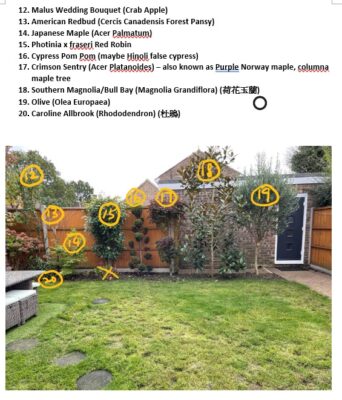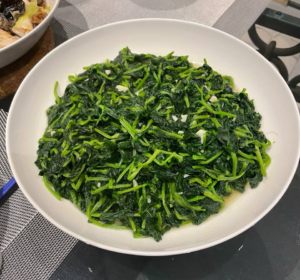
種植豆苗 Growing Pea Shoots
最近收割了一大盆豆苗;這是我在英國累積了兩年經驗之後,種得最好的一輪。
由於土地、時間和精力有限,我只種植街外買不到的蔬菜。嚴格來說,豆苗並不符合這個原則──英國是有豆苗售賣的,可是跟香港人吃的有點分別。本地人用豆苗來做沙律,每包只有很少份量,用香港人的烹調方法,一下鑊炒,只剩那麼一小撮,要買很多包才夠吃。
第一年種菜,我聽人說豆苗有不同品種,荷蘭豆、甜豆的葉都不盡相同,而香港人平常吃的豆苗是荷蘭豆的葉。於是我種了一批荷蘭豆,陸陸續續採摘了幾輪豆苗吃,可是種得不夠多,每次收成都不夠炒一碟菜。然而新鮮採摘的豆苗,確實美味,接著長出的荷蘭豆,新鮮採摘下來做沙律,好吃得不得了!
第二年,我看見別人說用超市買的乾青豆,一樣可以種植豆苗,我便試試。這比荷蘭豆種子便宜,而且葉子的味道跟荷蘭豆沒有兩樣。由於豆苗比其他蔬菜耐寒,在春初天氣仍冷、尚未能種其他蔬菜的時候,已經可以種植。我見花盆閒置着,便先用來種豆苗,待天氣暖一些,豆苗吃完了才改用種其他菜(即停止栽種,不繼續種出豌豆)。這個做法延長了花園可種菜的日子,使有限的空間增加了產量。我見這次成效不俗,於是在九月天氣轉冷,其他蔬菜陸續停產時,再撒了一些乾豆,種另一批豆苗,一直吃到十二月。此時我開始掌握了份量,了解到以我家兩個人吃為標準,每次起碼要種兩盒乾豆,每輪收成才足夠炒一碟菜。
我跟友人分享收成的照片,對方很訝異:「沒想到超市乾豆也能種出那麼粗壯的豆苗啊!」她一直以為礙於乾豆的品種,只能種出葉子細小的豆苗。經過一番討論後,我們相信是因為我用來很深的花盆來種植。一般網上資料都說豆苗根淺,毋須用很深的花盆種植,我想那主要適用於用來做沙律用的菜苗。然而以香港人的吃法,粗壯的豆苗是較合適的。我本來只一心想充分利用閒置的花盆,沒想到誤打誤撞地,因為用了深的花盆,種出了粗壯的豆苗。
今年是我第三年種豆苗了,我依舊在早春便把種子撒在空置的花盆中。累積了經驗和知識,我了解到原來這也是一項「肥田」行動──豆科植物能將大氣中的氮轉化為植物可吸收的養份,藏在其根部。我用花盆先種豆苗再種其他葉菜,正好運用了豆苗的特性。種完豆苗後,我剪掉豌豆地面的部份,保留根系在土壤中,讓其豐富的氮元素為之後的菜苗提供營養。這次為了「種肥」所有花盆的泥,我買了三盒乾豆來播種,結果收成時採摘了滿滿一大盆菜,大快朵頤!
種植豆苗的好處真的太多了,也很適合我的小菜園!我以後每年春秋兩季都會繼續栽種。
(文末有圖片展示種植過程。)
I recently harvested a large batch of pea shoots. It’s the best crop I’ve grown after two years of experience in the UK.
With limited space, time and energy, I only grow vegetables that aren’t readily available in stores. Pea shoots technically don’t fit this criterion – They are sold in the UK. However, they are somewhat different from the ones familiar to Hong Kongers. Local people use pea shoots for salads, typically in small packets. However, when cooked in the Hong Kong style, stir-fried, they shrink considerably, requiring multiple packets for a meal.
In my first year of gardening, I learned that there are various types of pea shoots. I read about the difference of the taste between the leaves of mangetout and sugar snap, and that the pea shoots commonly eaten in Hong Kong are from mangetout. So, I planted some mangetouts. I harvested a few rounds of pea shoots, but I didn’t grow enough; there wasn’t sufficient harvest for a stir-fried dish. Nonetheless, freshly picked pea shoots are delicious, and the subsequent mangetouts are excellent for salads!
In the second year, I discovered that I could grow pea shoots from store-bought dried peas. It’s a cheaper option than buying mangetout seeds, so I gave it a try and found that the taste of its leaves was no different from mangetout’s. Since pea shoots are more cold-resistant than other vegetables, I planted them early in the spring when the weather was still chilly. When it got warmer later, I switched to grow other crops. This way, I successfully extended the growing season, increasing yield in limited space. Then, I repeated the same idea in September as the weather gradually turn too cold for other vegetables. I sowed another patch of dried peas and kept harvesting pea shoots until December. By then, I had got a better idea of how much peas I needed to sow – for two people to have a decent amount for a stir-fried dish with each harvest, I needed to sow at least two boxes of dried peas each time.
When I shared photos of my harvest with a friend, she was surprised: “I didn’t expect store-bought dried peas to produce such large pea shoots!” She thought those dried peas would only produce small-leaved pea shoots. After some discussion, we concluded that it was because I used deep planters. Online sources often suggest growing pea shoots in shallow pots because people use them for salads. I used deep ones merely because I wanted to maximise the use of my planters. What I didn’t expect was this method would result in larger pea shoots that are better suited for Hong Kong-style cooking.
This year marks my third year of growing pea shoots, and I still sow seeds in empty planters in early spring. As my experience and knowledge have grown, I’ve learned that what I did was a good way for enriching the soil – leguminous plants can convert atmospheric nitrogen into a form that plants can use. After finishing growing pea shoots, I will cut away the above-ground portions of the plant, leaving the nitrogen-rich roots in the soil to pave the way for fertile soil for other vegetables. In order to fill all the planters, I sowed three boxes of dried peas, resulting in an amazingly abundant harvest!
The benefits of growing pea shoots are truly numerous. They are perfectly suited to my modest garden space. I will continue planting them every spring and autumn.
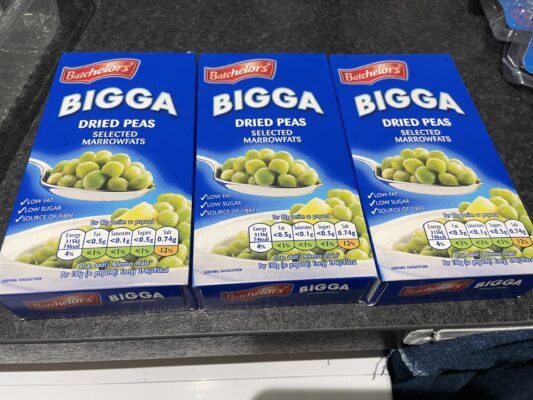
I sowed three boxes of dried peas on 9th February this year. (I am in Hardiness Zone 8)
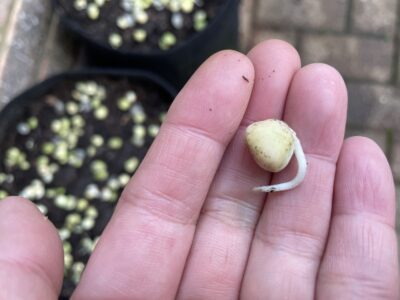
I soaked the dried peas in water and planted them in the soil after they had grown roots.
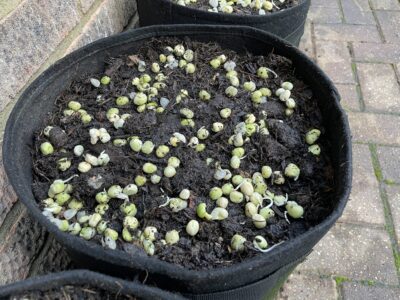
I just randomly scattered the peas in the planters, so the spacing was quite small.
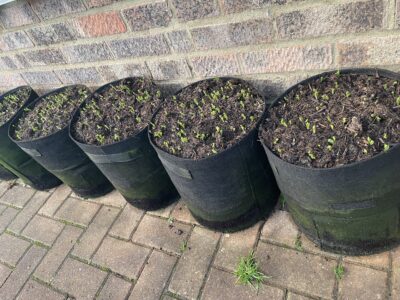
My grow bag is 35cm tall, deeper than what is normally suggest for growing pea shoots.
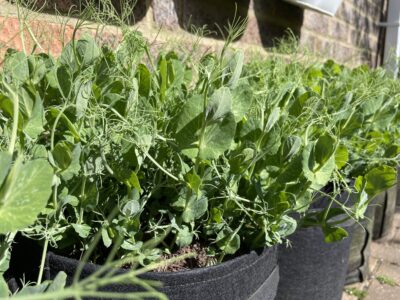
When the seedlings reached 15cm tall, I harvested the sprouts at the top; each harvest would stimulate growth, making the seedlings denser and resulting in a higher yield.
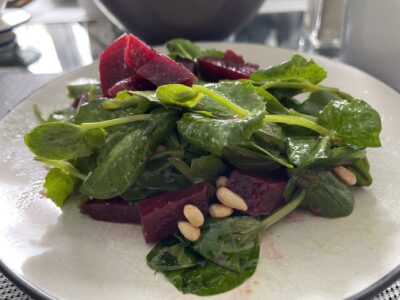
With a small harvest, I made a salad.
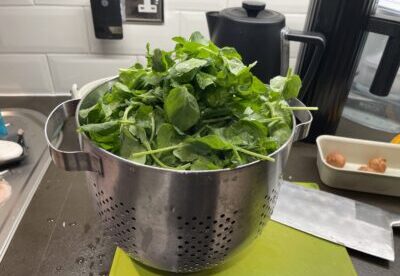
On 30th March, there were finally enough crops for a stir-fry dish!

We had a meal of stir-fried pea shoots with garlic – super tender and yummy!
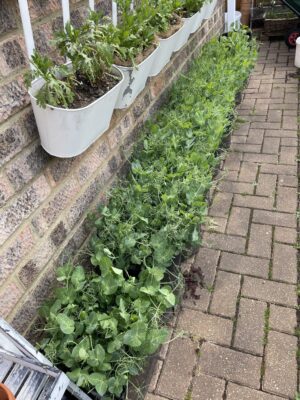
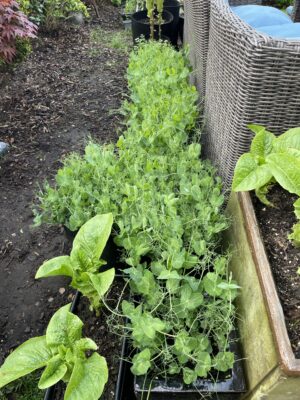
The tree boxes of peas were spread amongst around ten planters. Later, the soil in these planters will be fertilised by the peas and used to grow other vegetables.
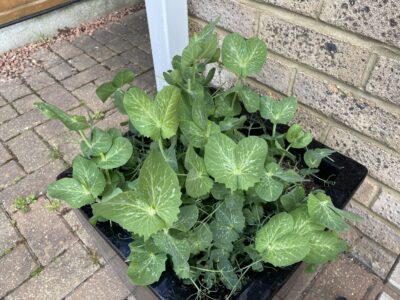
In one of the pots, the plants were spaced more sparsely. The pot was located in a spot that received the earliest morning sunlight. As a result, the leaves of the plants in this pot grew particularly large.
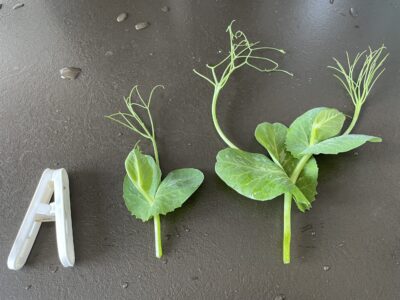
A comparison with the crops from the other planters clearly showed that the pea shoots in this pot were much large. The experiment proves that using deep planters, greater spacing and abundant sunlight can yield larger pea shoots suitable for stir-frying.

自家製堆肥 Homemade Compost
You May Also Like
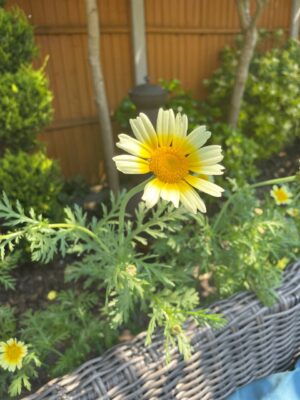
我怎樣決定種什麼菜?How Did I Choose What to Grow?
18 April 2023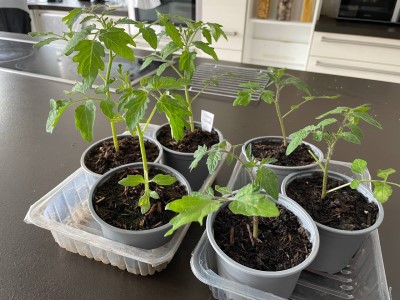
從巴士站到慈善店的車厘茄苗 From Bus Stop to Charity Shop: Cherry Tomato Seedlings
18 May 2023